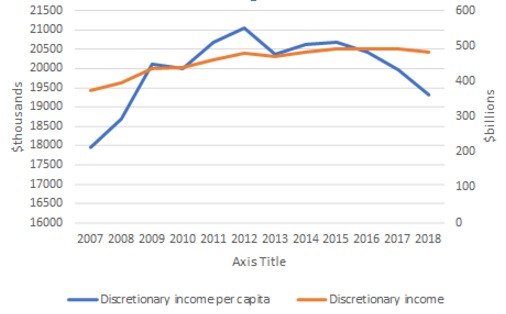 Australian consumers’ discretionary income is expected to decline two years in a row for the first time since 1992, according to the latest research from IbisWorld.
Australian consumers’ discretionary income is expected to decline two years in a row for the first time since 1992, according to the latest research from IbisWorld.
The market research firm forecasts a 3.2 per cent decline in discretionary income in the current financial year, following a 2.3 per cent fall in 2016-17, as spiralling gas and electricity prices, rent and dwelling costs, and private health insurance premiums force down the amount of spare cash individuals have.
Unavoidable costs, identified in IbisWorld research as necessary household expenses, are forecast to rise by 3.0 per cent in 2017-18, far outstripping anticipated disposable income growth of one per cent in the same year.
Sluggish wage growth and a rise in the cost of living are expected to place additional stress on the ability of Australian households in several different income brackets to pay for discretionary goods and services, according to the research.

IbisWorld research suggested electricity and gas prices will climb by 12 per cent in 2017-18, as increased costs from rising LNG exports and the closure of antiquated coal-fired power stations are passed on to consumers. Healthcare costs are forecast to rise by 4.4 per cent, as Australia’s ageing population places increased pressure on the system, along with soaring premiums for private health insurance services.
Rent and dwelling costs are also forecast to grow by 3.3 per cent, due to strong competition for rentals and pressure on the key metropolitan areas of Sydney and Melbourne caused by increases in the population living there.
With the continued forecast decline in discretionary spending, Nick Tarrant, IbisWorld senior industry analyst said electronics and department store retailers would be hardest hit.
“With falling discretionary income, weak sentiment and the incoming arrival of Amazon as well, we are expecting a lot of retailers, especially department stores, but also ones that rely on or sell consumer products that aren’t necessities to have a poor year,” Tarrant told IRW.
Tarrant also noted incomes are expected to fall across the economy, despite an expected rise in the population.
“Discretionary income growth until 2015-16 had largely been supported by Australia’s expanding population, driven by net migration. Income per capita has fallen from a peak in 2011-12, as the economy has struggled to transition from its reliance on the mining sector,” he said.
“Rising unemployment and a long-term decline in weekly hours worked have also reduced incomes on a per capita basis.”
Commenting on the last time discretionary income fell for two consecutive years, Tarrant said it was also the last time Australia experienced a recession, with interest rates at approximately 15-20 per cent.
Not just the disposable
According to Justin Ganly, retail & property consultant and managing director of Deep End Services, all retail sectors are in for a tough time, including those in the non-discretionary sector.
“We’re already seeing this for supermarkets that have just had their toughest year from a sales perspective in the past 25 years,” he told IRW. “Total sales growth for the supermarket sector is just 2.9 per cent, which is actually the same for all retail, so I think the effect of this isn’t going to be isolated…the pain is going to be spread across a lot of retail.”

Ganly expects online retailers to also be hit, to a lesser degree than store-based retailers, based on the perception and “largely reality” that online retail is generally a better value proposition.
Commenting on whether property firms would be concerned, based on the vast amount of current investment into redeveloping shopping centres across the Aussie retail landscape,
Ganly said landlords would know about the expected drop in discretionary spend, but would be alarmed if the dip becomes prolonged.
Pointing to low wages growth, which is up less than two per cent, Ganly said Australia is an environment where increases in retail expenditure in excess of wages have seen consumers dip into their savings.
“The problem we’ve got is that the household savings ratio over the past four years has dropped by almost four per cent from nine per cent to five per cent.
Ganly said interest rates hold the key to people’s spending habits in the short term.
“The typical household now has almost twice as much debt as they do annual household disposable income. It’s almost at 200 per cent, which is almost world-leading,” he said.
“As it is at the moment, interest rates are, as we know, at historically low levels so that debt can be serviced. However if they go up, servicing that debt becomes a big problem.”
Ganly added school fees rising by five per cent per annum as another expenditure competing for people’s income.
International gain, local pain
On the flip side, Ganly said “foreign raiders” in the large category format clothing store category, including H&M, Uniqlo and Zara, could come out winners in the current environment, as their “value proposition for customers is appropriate in these times”.
“From a shopping centre owner’s perspective, they’re also seen as attractive because they are bringing people into the centre who they otherwise might not see.”
Those in the takeaway and lifestyle food, also known as the fast casual industry, could potentially flourish in the current macro environment, said Ganly.
“There’s no doubt that there’s an appetite, no pun intended, for this fast casual sector and I think that some of the offers being put out there are very impressive. The question in some people’s minds is how many of these can you put into a centre before it becomes problem.”






